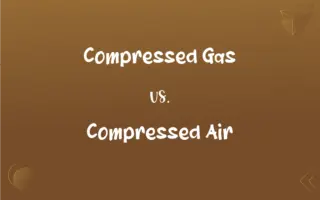Baroque Art vs. Renaissance Art: What's the Difference?
Edited by Aimie Carlson || By Harlon Moss || Published on December 14, 2023
Baroque art is characterized by drama, rich color, and intensity, while Renaissance art focuses on harmony, proportion, and realism.

Key Differences
Baroque art is known for its dramatic use of light and shadow, and emotional intensity. Renaissance art emphasizes harmony, balance, and lifelike realism.
Baroque art often depicts intense and dynamic scenes, with an emphasis on drama and movement. Renaissance art commonly portrays religious themes, human figures, and the natural world with a focus on clarity and realism.
Baroque artists used exaggerated motion and clear, easily interpreted detail to produce drama, exuberance, and grandeur. In contrast, Renaissance artists focused on linear perspective, proportion, and the anatomically correct representation of the human body.
Baroque art emerged in the early 17th century, often associated with the Catholic Counter-Reformation. The Renaissance period, beginning in the 14th century, marked the transition from the Middle Ages to modernity, emphasizing a rebirth of classical learning and wisdom.
Prominent Baroque artists include Caravaggio, Rembrandt, and Bernini. Renaissance art is exemplified by masters such as Leonardo da Vinci, Michelangelo, and Raphael.
ADVERTISEMENT
Comparison Chart
Stylistic Features
Dramatic, intense, emotional
Harmonious, proportional, realistic
Themes
Dynamic scenes, dramatic narratives
Religious themes, humanism, natural world
Techniques
Exaggerated motion, clear detail
Linear perspective, anatomical accuracy
Historical Context
17th century, Counter-Reformation
14th to 17th century, revival of classical learning
Notable Artists
Caravaggio, Rembrandt, Bernini
Leonardo da Vinci, Michelangelo, Raphael
ADVERTISEMENT
Baroque Art and Renaissance Art Definitions
Baroque Art
Baroque art emphasizes movement and dynamic scenes.
The dynamic movement in Rubens' paintings exemplifies the Baroque style.
Renaissance Art
Renaissance art focuses on humanism, proportion, and a realistic approach to depicting figures and nature.
Leonardo da Vinci's Mona Lisa is a classic example of the realistic portrayal in Renaissance art.
Baroque Art
Baroque art is characterized by dramatic expression, grandeur, and intensity of emotion.
Bernini's sculpture The Ecstasy of Saint Teresa embodies the dramatic emotion typical of Baroque art.
Renaissance Art
Renaissance art is known for its development of linear perspective.
Raphael's School of Athens showcases the use of perspective, a key feature of Renaissance art.
Baroque Art
Baroque art often involves complex compositions and rich, deep color.
Caravaggio's use of chiaroscuro in his paintings is a signature element of Baroque art.
Renaissance Art
Renaissance art often depicts classical themes and mythology.
Botticelli's The Birth of Venus illustrates the Renaissance fascination with classical mythology.
Baroque Art
Baroque art is known for its use of light and shadow to enhance drama.
Rembrandt's paintings often exhibit the intense contrast between light and dark, a hallmark of Baroque art.
Renaissance Art
Renaissance art emphasizes symmetry and clarity in composition.
Michelangelo's David exemplifies the symmetry and proportion celebrated in Renaissance art.
Baroque Art
Baroque art often includes ornate details and elaborate decorations.
The intricate details in the architecture of the Palace of Versailles reflect the extravagance of Baroque art.
Renaissance Art
Renaissance art includes a focus on the anatomical correctness of the human body.
Michelangelo's frescoes in the Sistine Chapel display a deep understanding of human anatomy, a Renaissance trait.
FAQs
What was the historical context for the emergence of Baroque art?
Baroque art emerged in the early 17th century, often linked to the Catholic Counter-Reformation.
What defines Renaissance art?
Renaissance art, originating in the 14th century, is characterized by its focus on realism, humanism, and classical themes.
Are religious themes more prevalent in Baroque or Renaissance art?
While both styles feature religious themes, Baroque art often presents them in a more dramatic and emotional manner compared to the harmonious depiction in Renaissance art.
How did Baroque artists use light in their paintings?
Baroque artists used light and shadow dramatically to create depth and intensify the emotional impact.
Did Renaissance art focus on realism?
Yes, Renaissance art is known for its realistic portrayal of figures and nature.
Why is human anatomy important in Renaissance art?
Human anatomy is important in Renaissance art as it reflects the movement's focus on realism and the human form.
What is Baroque art?
Baroque art is a style from the 17th century known for its drama, intensity, and emotional expressiveness.
How does Baroque art differ in emotion from Renaissance art?
Baroque art often exhibits more intense and overt emotion compared to the more restrained and balanced emotional expression in Renaissance art.
What cultural movement influenced Renaissance art?
Renaissance art was heavily influenced by a revival of classical learning and a focus on humanist principles.
What technique in painting did Renaissance artists pioneer?
Renaissance artists pioneered the use of linear perspective in painting.
Who are some famous Renaissance artists?
Famous Renaissance artists include Leonardo da Vinci, Michelangelo, and Raphael.
How did Renaissance art influence Europe?
Renaissance art influenced Europe by encouraging a shift towards realism, humanism, and a revival of classical learning.
Did Renaissance artists use mythology in their work?
Yes, Renaissance artists often incorporated classical mythology into their works.
Can Baroque art be identified by its use of color?
Yes, Baroque art often features rich, deep colors to enhance its dramatic impact.
What is an example of Baroque architecture?
The Palace of Versailles is an example of Baroque architecture, known for its elaborate decoration.
What themes are common in Baroque paintings?
Common themes in Baroque paintings include dramatic biblical scenes, grandeur, and intense emotion.
How does Baroque sculpture differ from Renaissance sculpture?
Baroque sculpture is more dynamic and dramatic, while Renaissance sculpture emphasizes proportion and idealized beauty.
How is Baroque art viewed in terms of ornamentation?
Baroque art is often viewed as more ornate and extravagant compared to the more balanced Renaissance style.
What impact did Renaissance art have on later artistic movements?
Renaissance art's emphasis on realism and perspective had a lasting impact, influencing many later artistic movements.
Is emotion a key element in Baroque art?
Yes, emotion is a key element, often depicted through dramatic scenes and expressive figures.
About Author
Written by
Harlon MossHarlon is a seasoned quality moderator and accomplished content writer for Difference Wiki. An alumnus of the prestigious University of California, he earned his degree in Computer Science. Leveraging his academic background, Harlon brings a meticulous and informed perspective to his work, ensuring content accuracy and excellence.
Edited by
Aimie CarlsonAimie Carlson, holding a master's degree in English literature, is a fervent English language enthusiast. She lends her writing talents to Difference Wiki, a prominent website that specializes in comparisons, offering readers insightful analyses that both captivate and inform.







































































